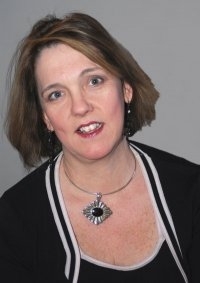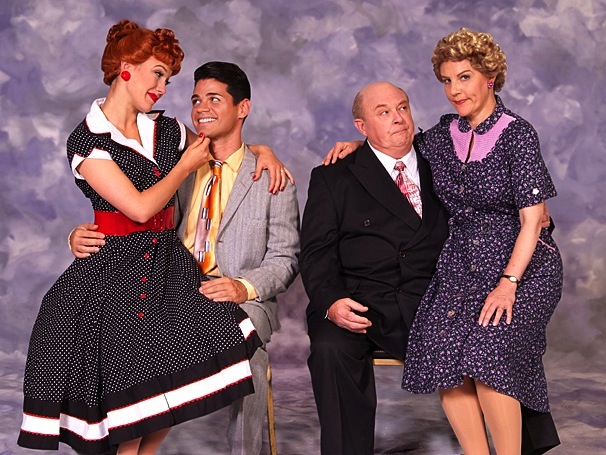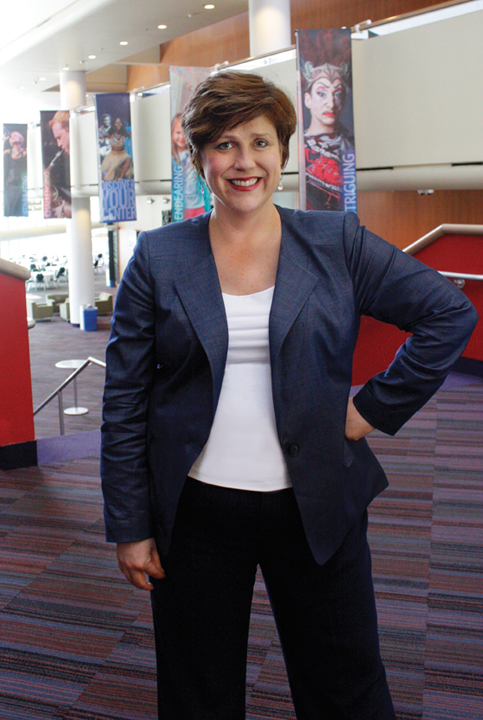Thea Brooks, Euriamis Losada, Kevin Remington & Lori Hammel in
I Love Lucy – Live on Stage (Photo by Ed Krieger)
I Love Lucy – Live on Stage
Adapted by Rick Sparks and Kim Flagg
Directed by Rick Sparks
Review by Kathi E. B. Ellis
Entire contents copyright © 2014 by Kathi E. B. Ellis. All rights reserved.
This week sees the kick-off the 2014-2015 PNC Broadway Louisville season. And with that comes one of the newer musicals that they have brought to Louisville in recent years. I Love Lucy originated in Los Angeles in 2011, subsequently moving to Chicago and then onto a national tour. The current tour, with many new players in its company, is in its early stages having begun in Miami last week. This is the second time recently that Broadway Louisville has ensured that Louisville audiences are able to experience new work early on its tour (Flashdance in January 2013 being the other production, coming to Louisville after its premiere in Pittsburgh.)
The vision of Kim Flagg and Rick Sparks for I Love Lucy – Live on Stage (the full title) is one hat captures the energy and ‘can do’ attitude of early network television and filmed-before-a-live-audience format. Flagg and Sparks and their design team recreate a television studio, complete with host, to entertain and orient the ‘audience’, as they/we prepare to watch the recording and broadcast of two episodes, “The Benefit” and “Lucy Gets Her Eyes Examined,” complete with live-sung commercials and an audience quiz to entertain the supposed-studio audience between the two episodes. The production’s excellent band doubles as the house band at The Tropicana in the latter episode.
Tuesday’s opening night audience clearly came prepared to enjoy their memories of the original television series and to reward the performers with generous laughter and applause when they successfully reproduced a physical or vocal signature of Lucille Ball, Desi Arnaz, Vivian Vance or Bill Frawley.
There is much in this engaging production that works. The creators patently love the original TV series, and this production is an affectionate homage to both the live-TV era and to this particular show, with no irony in the palette. This in turn allows the audience to travel back in time and memory to one of this country’s most loved television comediennes. Whether this is truly a musical, rather than a play with musical interludes is debatable; without the commercials there would be little focus on music; the first episode focuses on Lucy’s (Thea Brooks) inability to sing on key, one of the catalysts of the plot, and Ricky Ricardo (Euriamis Losada) has a club number in the second, (El Cubancherro) a great number, but a much-deserved showcase for Arnaz/Losada rather than essential to the plot.
Early comers get a taste of the tone of the evening when an announcement requests that transistor radios be turned off before the show begins. Mark Christopher Tracy (reprising his role as show host Maury Jasper from the original) continues to set the scene, economically and energetically grounding the actual audience into its role as studio audience – making sure that we all know how to handle the flashing applause sign. With a geographical nod to venue (this week’s shtick is Seabiscuit), together with a riff about the bus from Kentucky bringing folks to the Hollywood studio, we are ready to watch the taping of the night’s first episode.
The high-energy ensemble take on various roles in the Crystaltones – the singers of the advertisements – as well as other characters in the episodes and studio staff. There were times when the audience sang along with the commercials, a chord clearly being struck. The Crystaltones began a trifle shakily with the dance routines not being as unified as one would wish. This may have been opening night-in-a-new-venue nerves as the routines became sharper during the evening. The dance highlight of the production is the jitterbug, taught to Lucy by King Kat Walsh (Richard Strimer, also the dance captain) for a within-the-show audition, with both the lesson and the audition being part of the episode. The Pleasant Peasant Girls amateur performance at the eponymous benefit lay awkwardly between the truly amateur and performers playing ‘to be amateur’.
Of course, the audience came to enjoy the lead characters and their friends the Mertzes, played by Kevin Remington (reprising his role from the first tour) and Lori Kimmel. In the first scene of the first episode we find all four playing cards and are quickly introduced to recognizable quirks and traits of the four characters – with the audience keeping pace adding appreciative chuckles to the on-set action. Remington and Kimmel inhabit the former Vaudeville couple with facility, including their Varsity Drag number in the second episode of the evening. Mr. Losada brings the Desi Arnaz/Ricky Ricardo brio to life, in equal measure charming and chauvinistic. The couple of numbers that his character has demonstrates that Losada’s voice continues to mature, as he easily fills the Whitney Theatre with soaring notes. Ms. Brooks’ bio lists Lucy as her first leading role. Brooks has demonstrably captured Ms. Ball’s signature moves, facial expressions, and vocal tics, and yet she rarely attains the exuberance and ebullience that are so characteristic of the Lucy character; Lucy is not the largest character on the set or in the studio in the way that I Love Lucy is remembered. The most successful interaction between Lucy and Ricky is the song and joke routine that rounds out “The Benefit” in which both performers have an easy rapport between them that suggests the longtime volatile relationship between the originals.
The convention of the production is a smart way to bring this iconic experience to a stage format. And yet it is a convention that is not entirely successful in its execution executed. It is obvious when the ‘live broadcast’ convention is being used – flashing applause light; costume changes on set; the host counting in the top of the scene, for instance. However there are missed opportunities, an example being a visit to the eye doctor’s office which is played in a contained area to one side of the stage – but neither onstage TV camera is moved into place to suggest a close up shot, even though the function of the cameras has been explained by the host at the beginning of the evening. A finer line is the convention of moving between the studio and the set in the studio; a simple device of drawing aside a curtain to reveal the set is both practical and believable within the TV studio context; however on Tuesday evening the ‘studio’ lights were frequently brought up before the TV stage hands were finished with their set up. Even within the framework of live TV, which may not always go as smoothly as wished, this appears sloppy – and especially when there is an incident written into the stage production in which the episode recording is halted because there was a mistake.
More troublesome technically, were sound problems with the microphone of the planted audience member (Mrs. Birdie Mae Figg, from Oklahoma, played by Denise Moses). In addition, as so often in the Whitney, the balance between the music and vocals was less than desirable making some ensemble lyrics difficult to understand. Several times performers exited close to the downstage curtain, with their costumes catching the drape and revealing the backstage of the Whitney (rather than the rest of the studio). Opening night also saw a handful of moments when the overall lighting was out of sync with the action of the episodes. It is to be hoped that as this company settles into the routine of performing in spaces of different dimensions, such sloppiness is ironed out.
The evening lasts an hour and forty minutes without an intermission; the two episodes, obviously, take up little more than an hour – the new material created by Flagg and Sparks, a lovingly-created pastiche of a very specific genre at a specific time, is not substantial enough to maintain the almost forty remaining minutes of the show. However, for audiences who remember I Love Lucy on network television, or who stream episodes today, the four principals go a long way towards recreating these iconic TV characters.
(Ms. Ellis has previously worked with Euriamis Losada at Broward Stage Door Theatre and New Theatre in Florida.)
I Love Lucy – Live on Stage
October 7 – 12, 2014
PNC Broadway in Louisville
Kentucky Center for the Arts
501 West Broadway
Louisville, KY 40202
http://louisville.broadway.com/shows/tickets/
 Kathi E.B. Ellis is a member of the Lincoln Center and Chicago Directors’ Labs and an associate member of the Stage Directors & Choreographers Society. She has attended the LaMama Directing Symposium in Umbria, Italy, and is featured in Southern Artisty, an online registry of outstanding Southern Artists. Her directing work has been recognized with nominations for the South Florida Theatre Carbonell Award. Locally, Kathi is a member of Looking for Lilith Theatre Company, a founding principal of StageLab theatre training studio, and is part of ShoeString Productions an informal producing collective. She has written book reviews and articles for Southern Theatre, the quarterly publication of the Southeastern Theatre Conference, and was a contributing writer for JCPS’ textbook for the 11th grade Arts and Humanities survey course and for YouthArts Tapestry, a Kentucky Arts Council publication.
Kathi E.B. Ellis is a member of the Lincoln Center and Chicago Directors’ Labs and an associate member of the Stage Directors & Choreographers Society. She has attended the LaMama Directing Symposium in Umbria, Italy, and is featured in Southern Artisty, an online registry of outstanding Southern Artists. Her directing work has been recognized with nominations for the South Florida Theatre Carbonell Award. Locally, Kathi is a member of Looking for Lilith Theatre Company, a founding principal of StageLab theatre training studio, and is part of ShoeString Productions an informal producing collective. She has written book reviews and articles for Southern Theatre, the quarterly publication of the Southeastern Theatre Conference, and was a contributing writer for JCPS’ textbook for the 11th grade Arts and Humanities survey course and for YouthArts Tapestry, a Kentucky Arts Council publication.





